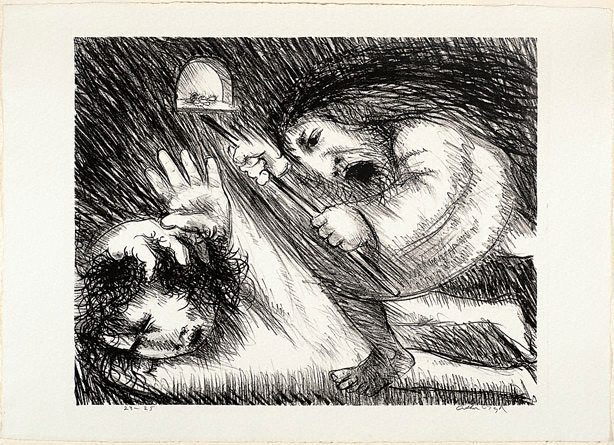The National Gallery of Australia is exhibiting Arthur Boyd: Agony & Ecstasy until 9 November. It is the first major exhibition of Boyd’s art in over twenty years. The exhibition includes more than 180 spectacular works of art including paintings, tapestries, prints, drawings, sculptures and ceramics. The exhibition is on display in Canberra only.
The focus of the exhibition is on Arthur Boyd as an intense, passionate visionary capable of plumbing the depths and vicissitudes of human emotions. The show is not a retrospective but rather provides the opportunity to take a close look at a number of works that have never or rarely been previously exhibited, as well as series and groups of works, undertaken from 1937 through to 1980. While the Australian landscape informs some works, the emphasis is on the way that Boyd engages with human experience—starting with an intense early self-portrait painted when he was only seventeen through to works of great potency undertaken four decades later. While there are intimate as well as expansive works, the sheer scale of many of them mean that this is a once in a lifetime opportunity to see them together. While the public are perhaps very familiar with Boyd’s works from the 1940s and 50s, the exhibition also seeks to emphasise the strengths of his art created in the 1960s and 70s.
- Arthur Boyd
Self portrait in red shirt 1937
oil on canvas on cardboard
51.5 x 45.4 cm
National Gallery of Australia, Canberra
The Arthur Boyd gift 1975
- Arthur Boyd
Nebuchadnezzar making a cloud 1968
oil on canvas
174.8 x 183. 2 cm
National Gallery of Australia, Canberra
The Arthur Boyd gift 1975
- Nebuchadnezzar being struck by lightning 1969
oil on canvas
174.3 x 183.2 cm
National Gallery of Australia, Canberra
The Arthur Boyd gift 1975
- Paintings in the studio: 'Figure supporting back legs' and 'Interior with black rabbit' 1973–74
oil on canvas
313.5 x 433.2 cm
National Gallery of Australia, Canberra
The Arthur Boyd gift 1975
- Birth of Narcissus 1976
oil on canvas
152.5 x 122.0 cm
National Gallery of Australia, Canberra
Gift of Joseph Brown 1991
- The unicorn sees the lady 1973–74, plate 10 in The lady and the unicorn, a portfolio of twenty-four etchings
etching and aquatint
78.8 x 57.6 cm
National Gallery of Australia, Canberra, purchased 1978
Reproduced with the permission of Bundanon Trust
- The prodigal son 1948–49, from the Harkaway mural
casein tempera, powder colour on plaster on mortar
230.0 x 227.0 cm
National Gallery of Australia, Canberra
Gift of Arthur Boyd 1969
Reproduced with the permission of Bundanon Trust
- The mining town (Casting the money lenders from the temple)c.1946
oil and tempera on composition board
87.4 x 109.4 cm
National Gallery of Australia, Canberra, Purchased 1974
Reproduced with the permission of Bundanon Trust
- Europa and the bull 1951–52
earthenware, coloured slips, clear glaze
39.9 x 42.9 cm
National Gallery of Australia, Canberra
The Arthur Boyd gift 1975
The exhibition is extensive and includes important series such as the dramatic, biblical Nebuchadnezzar paintings, exquisite prints and large tapestries on the theme of The lady and the unicorn, lively costume designs for the ballet Elektra (choreographed by Robert Helpmann in 1963) and his remarkable Caged painter series.
St Francis beaten by his father
A special room has also been constructed for Boyd’s visionary images on the life of St Francis, including prints and pastels as well as a dazzling group of large-scale tapestries not previously exhibited together.
St Francis beaten by his father
A special room has also been constructed for Boyd’s visionary images on the life of St Francis, including prints and pastels as well as a dazzling group of large-scale tapestries not previously exhibited together.
Among the many works that have not been exhibited before is The prodigal son, a large fragment of a mural that was painted by Arthur for his uncle, the well-known novelist, Martin Boyd. Undertaken in 1948, its original location was the dining room of a house known as The Grange, built by his great grandparents in 1866 at Harkaway near Berwick in Victoria. Sadly, The Grange was eventually demolished to make way for a quarry. After years of thwarted attempts to save the mural, four relatively large components and several small sections were saved and eventually came to the National Gallery of Australia..









